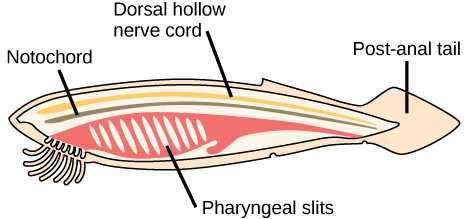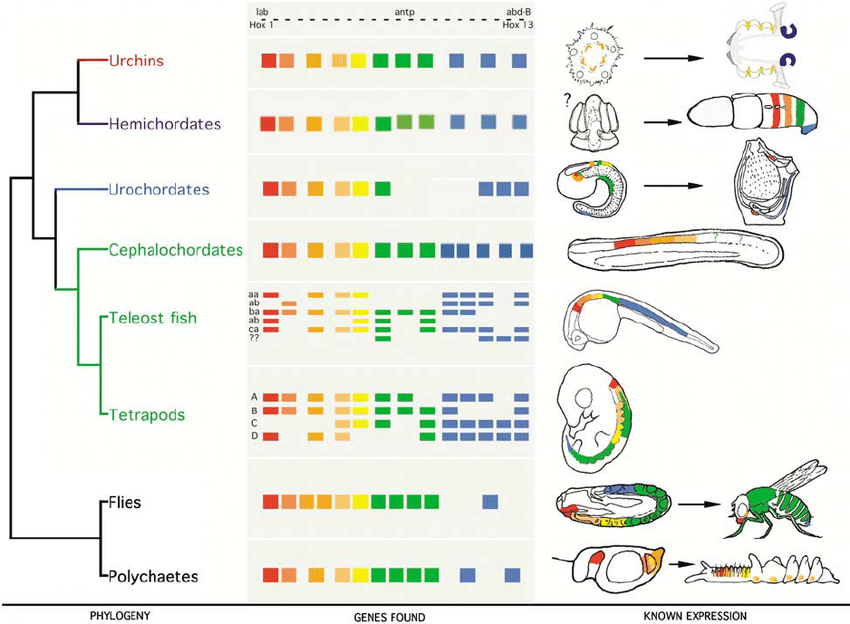Chordata
Vertebrates are among the most recognizable organisms of the animal kingdom. More than 62,000 vertebrate species have been identified. The vertebrate species now living represent only a small portion of the vertebrates that have existed. The best-known extinct vertebrates are the dinosaurs, a unique group of reptiles, which reached sizes not seen before or after in terrestrial animals. They were the dominant terrestrial animals for 150 million years, until they died out in a mass extinction near the end of the Cretaceous period. Although it is not known with certainty what caused their extinction, a great deal is known about the anatomy of the dinosaurs, given the preservation of skeletal elements in the fossil record. Currently, a number of vertebrate species face extinction primarily due to habitat loss and pollution.
According to the International Union for the Conservation of Nature, more than 6,000 vertebrate species are classified as threatened. Amphibians and mammals are the classes with the greatest percentage of threatened species, with 29 percent of all amphibians and 21 percent of all mammals classified as threatened. Attempts are being made around the world to prevent the extinction of threatened species. For example, the Biodiversity Action Plan is an international program, ratified by 188 countries, which is designed to protect species and habitats.
Vertebrates are members of the kingdom Animalia and the phylum Chordata (this phylum also includes two groups of invertebrate chordates).
Characteristics of Vertebrates
The first fossils of chordates appear in the Cambrian. These are small, soft-bodied organisms that appear to have played a relatively minor role in marine ecosystems compared to the cnidarians, arthropods, molluscs, and several other phyla. However, within the next 100 million years, one chordate taxon, the vertebrates, had achieved great evolutionary success, becoming dominant animals in the marine environment, and later making the transition to dominant animals in terrestrial ecosystems. Adults are bilaterally symmetrical, present in marine, freshwater, or terrestrial habitats. Chordates are dioecious (separate sexes). Definitive chordate characters include:
The notochord, which is a flexible, rod-shaped structure that is found in the embryonic stage of all chordates and in the adult stage of some chordate species. It is located between the digestive tube and the nerve cord and provides skeletal support through the length of the body. In some chordates, the notochord acts as the primary axial support of the body throughout the animal’s lifetime. In vertebrates, the notochord is present during embryonic development, at which time it induces the development of the neural tube and serves as a support for the developing embryonic body. The notochord, however, is not found in the postnatal stage of vertebrates; at this point, it has been replaced by the vertebral column (that is, the spine).
The dorsal hollow nerve cord derives from ectoderm that rolls into a hollow tube during development. In chordates, it is located dorsal to the notochord. In contrast, other animal phyla are characterized by solid nerve cords that are located either ventrally or laterally. The nerve cord found in most chordate embryos develops into the brain and spinal cord, which compose the central nervous system.
Pharyngeal slits are openings in the pharynx (the region just posterior to the mouth) that extend to the outside environment. In organisms that live in aquatic environments, pharyngeal slits allow for the exit of water that enters the mouth during feeding. Some invertebrate chordates use the pharyngeal slits to filter food out of the water that enters the mouth. In vertebrate fishes, the pharyngeal slits are modified into gill supports, and in jawed fishes, into jaw supports. In tetrapods, the slits are modified into components of the ear and tonsils. Tetrapod literally means “four-footed,” which refers to the phylogenetic history of various groups that evolved accordingly, even though some now possess fewer than two pairs of walking appendages. Tetrapods include amphibians, reptiles, birds, and mammals.
The post-anal tail is a posterior elongation of the body, extending beyond the anus. The tail contains skeletal elements and muscles, which provide a source of locomotion in aquatic species, such as fishes. In some terrestrial vertebrates, the tail also helps with balance, courting, and signaling when danger is near. In humans, the post-anal tail is vestigial, that is, reduced in size and nonfunctional.

Text adapted from “Biology” by Openstax College. Download for free at: http://cnx.org/content/col11448/latest/
Hox Gene Duplication
Homeobox, or Hox, genes play a key role in segmentation and development. Vertebrates are thought to have at least 4 gene clusters, which suggests at least two gene duplication events since invertebrates. This provides for great morphological complexity, and allows for massive diversity of form and structure.

Systematics & Diversity
- Subphylum Urochordata– Tunicates. Solitary or colonial; outer covering (tunic) present; many definitive chordate characteristics not always present in adults; incurrent (oral) and excurrent (atrial) siphons present. Larvae possess definitive chordate characters.
- Subphylum Cephalochordata– Lancelets. Small shallow-water benthic marine organisms with a fish-like shape; filter feeders; all chordate characteristics present in adults.
- Subphylum Craniata (Vertebrata) – Vertebrates. Brain (a complex bundle of neurons at anterior end of dorsal hollow nerve cord) present; notochord usually supplemented or replaced by a bony or cartilaginous vertebral column (except hagfish) and brain case; ventral heart with 3-4 chambers; paired kidneys used for excretion and/or water/solute balance. Vertebrates possess a unique tissue type = neural crest tissue.
Vertebrates can be broadly divided into two groups based on the presence or absence of jaws: the agnathans (jawless vertebrates) and the gnathostomes (vertebrates with jaws). The gnathostomes include two major vertebrate groups: the “fishes” and the tetrapods. Fishes are the most speciose group of vertebrates, with at least 21,000 identified species. The fishes constitute a paraphyletic group (i.e., a group that includes a common ancestor but not all of its descendants, hence they do not appear in bold face text here), but are discussed together because of their shared characteristics or shared ancestral homologies (e.g., they live in water, they possess gills and fins).
The terrestrial vertebrates, also called tetrapods, are also very diverse (~20,000 species). The tetrapods are monophyletic and most of them have four limbs (some, like snakes, have lost their limbs). Tetrapods usually live on land and breathe with lungs. The amphibians usually spend at least part of their lives in the water, and some other tetrapods spend some or all of their lives associated with aquatic or marine habitats (e.g., turtles, crocodiles, penguins, seals and whales). All of these animals are descended from fully terrestrial vertebrate ancestors (i.e., they are secondarily aquatic). In addition, fully powered flight has evolved at least three times in the tetrapods (birds, pterosaurs, bats).
Agnathans
- Class Myxini: Hagfishes. Cranium present but vertebrae absent; no paired appendages (no pectoral or pelvic fins); notochord persists in adult; gill slits form >10 gill pouches in adult; slime glands; no scales, no jaws, simple eyes. Marine only.
- Class Petromyzontiformes (Cephalaspidomorpha): Lampreys. Rudimentary cartilaginous vertebrae; lack paired fins; notochord persists in adult; gill slits form seven gill pouches in adult; adults have round sucking mouth (cyclostomes) for ectoparasitism on teleost fish; larva are filter-feeders in freshwater streams; no scales, no jaws, 3 chambered heart (sinus venosus, atrium, ventricle).
Gnathostomes
Fishes
- Class Chondrichthyes: Sharks, rays, and ratfishes. Cartilaginous endoskeleton; jaws present; notochord usually reduced in adult; vertebrae present; paired appendages (fins); almost always marine (few exceptions = bull sharks, rays, and many extinct freshwater forms); teeth not fused to jaws. The most well known fish in this group are in the subclass Elasmobrachii (“strap-gills”). In addition to the above features, these have gill slits (5-7 pair) without covers; tooth-like placoid scales; upper jaw not fused to braincase; a rigid dorsal fin, a 3-chambered S-shaped heart. Many live-bearing (viviparous) forms. Fertilization internal.
- Class (or superclass) Osteichthyes: Bony Fishes. Bony endoskeleton (usually); jaws present; notochord often absent in adult; bony or cartilaginous vertebrae present; paired appendages (fins); a variety of scales present; gills covered by an operculum; pharyngeal outpocketings that function as lungs or swim bladders; a 3-chambered S-shaped heart.
- Sub-Class Actinopterygii: Ray-finned fishes, fin musculature inside body wall. Lungs or swim bladders usually present. Includes most commercially important groups: trout, tuna, perch, cod, billfish, etc.
- Sub-Class Sarcopterygii: The lobe-finned fishes, with fin musculature in the fins. This group includes 2 living taxa. The first is the Actinistia, also referred to as crossopterygians. These are the coelacanths. Lungs present in extinct, ancestral freshwater forms; pectoral and pelvic fins homologous with tetrapod limbs. 1 or 2 species of coelacanths (only extant forms) are live-bearing marine forms. The second group of sarcopts are the Dipnoi, orlungfishes. Lungs connected to pharynx. Lungfish surface to ‘gulp’ air. Also have gills. 3 extant genera. May aestivate in mucous “cocoon” if water source dries up.
Tetrapods
Tetrapods are a monophyletic group of terrestrial vertebrates, having evolved from Sarcopterygian fishes. To better understand this transition, please view this short film:
Tetrapods are monophyletic and have bony skeletons. Besides the following characteristics, the tetrapods are classified by their skull morphology. These skull characteristics can be examined in the many extinct fossil groups. The Linnean classification of tetrapods places them into four classes. However, their taxonomy is currently under revision.
- Class Amphibia (Lissamphibia) – (frogs, salamanders, and tropical limbless caecillians) With some notable exceptions the amphibians lay their eggs in water, where an aquatic larval stage develops. The larva breathes with gills. The terrestrial adults either breathe with lungs or directly through the integument (skin specialized for cutaneous respiration). Amphibians have smooth, moist skin without scales or other covering. They are usually therefore associated with water or live in moist terrestrial environments. Have a four-chambered (sinus venosus, 2 atria, 1 ventricle) heart and pedicellate teeth.
- Class Reptilia (a paraphyletic group that comprises all amniotes except mammals and birds)
- Lepidosaurs (Tuatara; snakes and lizards [squamates]) – Possess a diapsid skull, scaly impermeable integument, 3 chambered heart, ectothermic metabolism, male squamates with hemipenes (two penis heads), adapted for terrestriality (some secondarily aquatic). Many viviparous.
- Testudines/Chelonia (turtles) – They have an anapsid skull, a bony or leathery shell composed of a carapace (top) and plastron (bottom), 3-chambered heart, ectothermic metabolism, and are oviparous (egg-laying) with an amniotic egg.
- Crocodilians – Members of archosaur lineage. Crocodiles, alligators, caiman, and gharials. Possess a diapsid skull, antorbital fenestra, four-chambered (2 atria, 2 ventricles) heart, and ectothermic metabolism. All are oviparous.
- Class Aves – Birds, like crocodilians, are a member of the archosaur lineage and evolutionarily derived from a reptilian ancestor. They have a diapsid skull, an amniotic egg, feathers, a toothless bill, and endothermic metabolism. Teeth present in extinct basal birds. They share several derived features with crocodilians, such as a hole in the skull anterior to the eye (antorbital fenestra) and a four-chambered heart, that unite both groups. All are oviparous.
- Class Mammalia – The mammals have hair/fur, mammary glands, and a synapsid skull. Most species have live birth, though extant monotremes lay amniotic eggs with a leathery shell. They have a four-chambered heart with anatomically separated chambers.